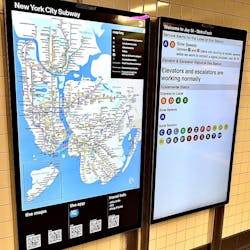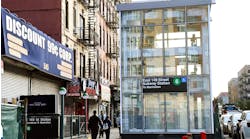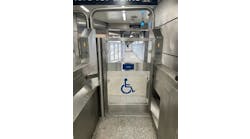NYC Transit announces surge of ‘excited’ feedback for Jay St-Metro Tech Accessible Station Lab
Initial feedback from customers and advocates about the station accessibility features being tested at the New York City Transit’s (NYCT) Accessible Station Lab at the Jay St-Metro Tech A, C, F, R station have great potential to make subway stations more accessible for riders of all abilities, according to NYCT.
The program at Jay St-MetroTech is testing more than a dozen new features such as smartphone apps for wayfinding, floor treatments, braille and tactile maps, digital signage and other tools for in-station navigation. Most of the features will remain in the station through early 2020.
NYCT says community engagement is a critical part of the station lab and says it has conducted at least 30 tours and received hundreds of survey responses since the October launch of the “living lab” at the station in downtown Brooklyn. NYCT encourages customers to continue providing direct feedback. Surveys will be accepted through Jan. 17, 2020, although customers are always encouraged to provide feedback about station accessibility and other topics through the customer feedback form online.
“It’s really encouraging to not only see so many customers test the features as they travel through the station but to ask questions and provide comments as well," said Alex Elegudin, NYCT senior advisor for systemwide accessibility. "We welcome the honest feedback and look forward to receiving results that will help us determine what features to incorporate into future accessibility projects.”
“The Mayor’s Office for People with Disabilities (MOPD) is excited to partner with the [Metropolitan Transportation Authority] on initiatives such as the Accessible Station Lab, which represents what the future of an accessible subway system could look like based on feedback from, and the needs of, New Yorkers and visitors with disabilities,” said MOPD Commissioner Victor Calise. “These features greatly improve the transit experience of people with mobility, hearing, vision and intellectual/developmental disabilities. When expanded to more stations, they can be true game-changers for making the subway system more accessible.”
NYCT says accelerating accessibility is a top priority. The 2020-2024 Capital Plan includes a commitment of more than $5 billion to make an additional 70 subway stations ADA accessible, ensuring customers will be no farther than two stops from an accessible station anywhere in the system. The MTA has also made it a priority to improve communication with customers on the real-time status of elevators and escalators, improve audio and visual access to information throughout the system, and explore new approaches to priority and courtesy seating on buses.
Features being tested in the pilot program include:
Physical Wayfinding Features:
Tactile Guideways: Blue guidance tiles with raised bars or domes throughout the main mezzanine and supporting braille signage at decision points. NYCT is testing different guideway materials including hard plastic and rubber to determine which customers prefer.
Tape Guideways: Three different brightly colored tape guideways on the floor to indicate accessible and transfer paths, especially helpful for those with cognitive disabilities and forms of vision loss; plus, six boarding area floor markers that indicate the Accessible Boarding Area on each platform.
Stair Warnings: Yellow warning strips with truncated domes at the top of stairs and colored tape at the bottom of stairs on each of the stations’ 50 staircases.
Touch Graphic Maps: Interactive tablet map on the main mezzanine showing station environment; plus, tactile/braille line map on the R platform.
Five New Wayfinding Apps
Waymap: Uses beacons at entrances, exits and around key features to guide users through station; uses audio and “smart routing” for those who are blind or low vision; available in multiple languages.
NaviLens & NaviLens GO: More than 100 unique, QR-style codes on signage throughout the station to turn signs into audio that provide wayfinding, train arrival and trip planning. Navilens GO uses the same codes to create virtual arrows to help guide users.
AIRA: Service that connects users to trained live agents who provide digital descriptions to guide users to their destinations using smart phone camera.
Magnus Cards: Geared toward people with cognitive disabilities, each card deck provides step-by-step visual, audio and text instructions for navigating the station, using MetroCards, train rides and transfers and reading station maps and signs.
Click & Go Wayfinding: Large tactile station environment maps on mezzanines, dozens of pre-scripted audio routes provided via app with beacons for additional information and digital low-vision maps of routes throughout the station.
And other features such as:
New Customer Information Centers (CICs): Testing includes new ways to display escalator and elevator outage information to screens.
Accessible Pathway and Alternate Route Signage: 15 new diagrams that map alternate routes in the event of an elevator outage and highlight the accessible path of travel from street to each platform.
Hearing Loop at Bowling Green: A hearing induction loop on the platform can help customers who use hearing aids or cochlear implants understand station announcements like train arrivals and Public Service Announcements. This feature is being tested at the Bowling Green station in lower Manhattan.
The full list of vendors participating in the project as well as a link to the customer feedback survey is available on the MTA website.



